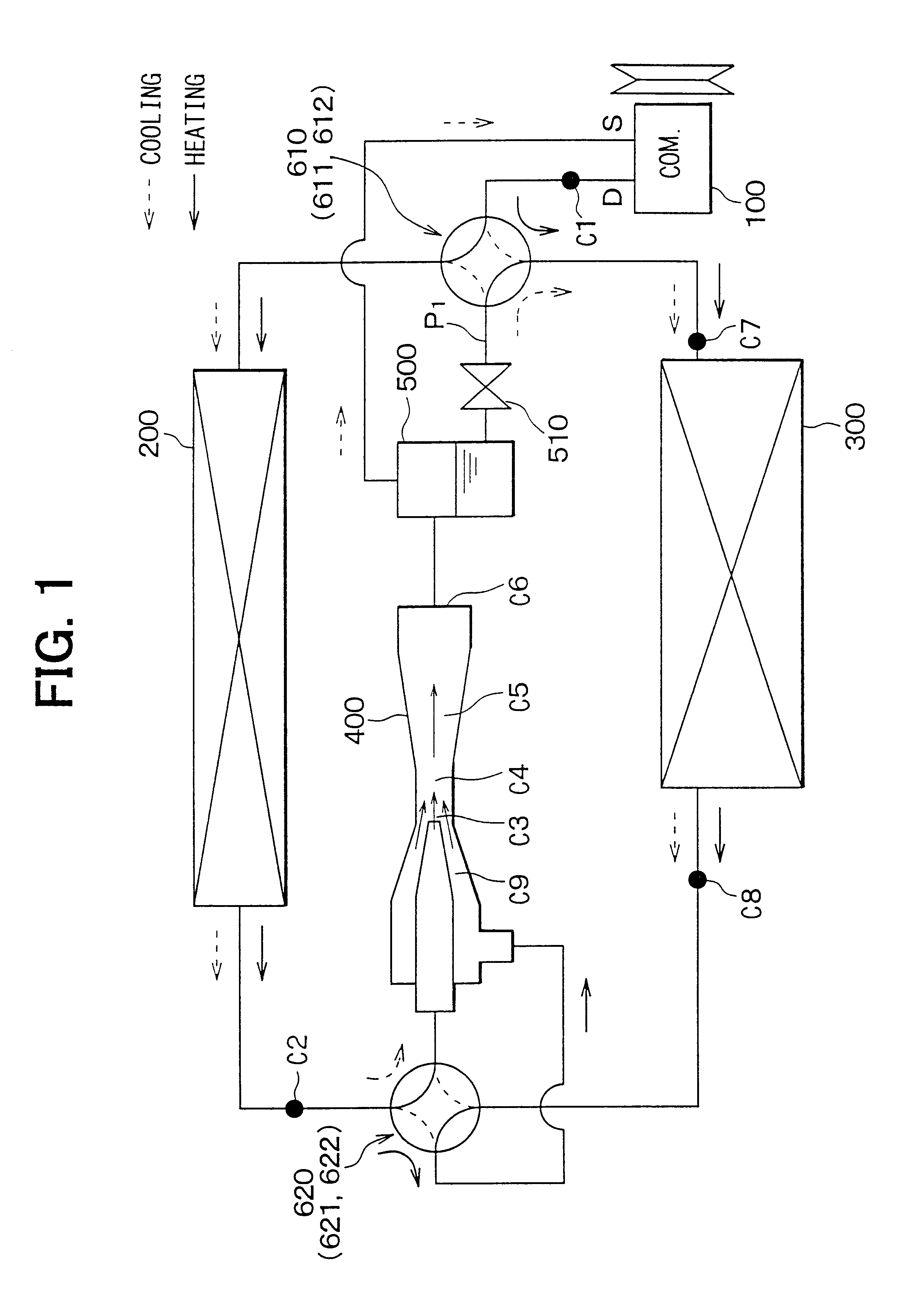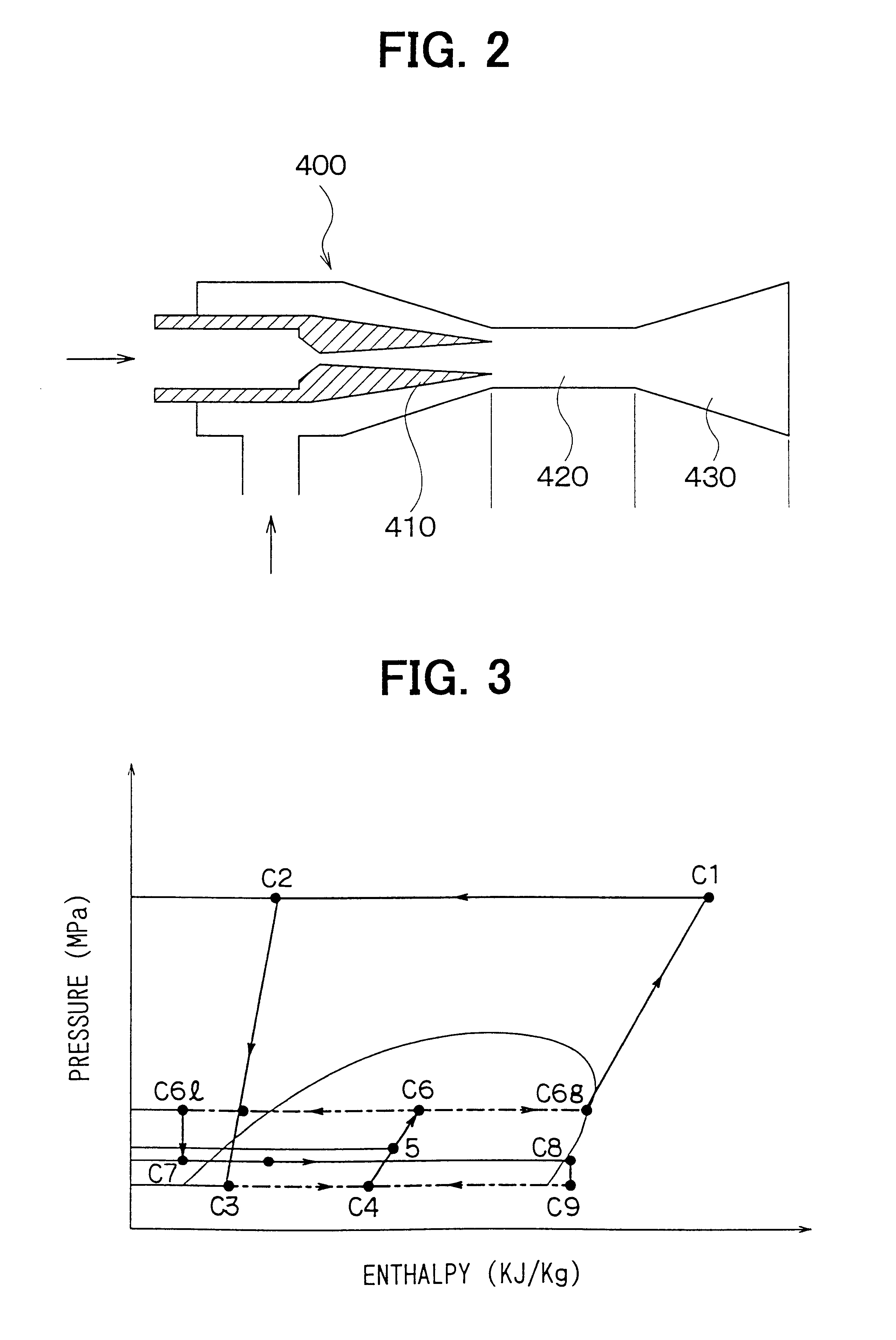Ejector cycle system
a technology of ejector cycle and cycle system, which is applied in the direction of refrigeration components, transportation and packaging, light and heating apparatus, etc., can solve the problems of insufficient improvement of heating performance, difficult to be suitable for heating operation, and difficult to improve heat exchange performance in each of the interior heat exchanger and the exterior heat exchanger
- Summary
- Abstract
- Description
- Claims
- Application Information
AI Technical Summary
Benefits of technology
Problems solved by technology
Method used
Image
Examples
first embodiment
A first preferred embodiment of the present invention will be now described with reference to FIGS. 1-3. In the first embodiment, an ejector cycle system of the present invention is typically used for a vehicle air conditioner.
As shown in FIG. 1, a compressor 100 is driven by a driving source such as a vehicle engine (not shown) to suck and compress refrigerant (e.g., carbon dioxide in the first embodiment). In an exterior heat exchanger 200, refrigerant in the ejector cycle system is heat-exchanged with air (outside air) outside a passenger compartment. In an interior heat exchanger 300, refrigerant in the ejector cycle system is heat-exchanged with air to be blown into a passenger compartment. An ejector 400 decompresses and expands refrigerant at a high pressure side so that gas refrigerant evaporated at a low pressure side is sucked therein, and converts an expansion energy to a pressure energy to increase a pressure of refrigerant to be sucked into the compressor 100.
As shown i...
second embodiment
Specifically, as shown in FIG. 4, a solenoid two-way valve 630 for opening and closing a refrigerant passage is provided at a refrigerant instruction side of the nozzle 410 of the ejector 400. Further, a decompression device (e.g., a fixed restrictor in the second embodiment) 640 is provided in a refrigerant passage through which the exterior heat exchanger 200 is connected to a refrigerant outlet side of the interior heat exchanger 300. A three-way valve 631 is provided in a refrigerant passage to switch any one of a case where refrigerant flows from the interior heat exchanger 300 into the mixing portion 420 of the ejector 400 and a case where refrigerant flows from the interior heat exchanger 300 to the fixed restrictor 640.
Next, the cooling operation and the heating operation of the ejector cycle system according to the second embodiment will be now described.
In the cooling operation, refrigerant discharged from the compressor 100 flows through the first four-way valve 610, the ...
third embodiment
Accordingly, in the cooling operation of the ejector cycle system of the third embodiment, refrigerant discharged from the compressor 100 flows through the first four-way valve 610, the exterior heat exchanger 200, the three-way valve 633, the ejector 400, the first four-way valve 610 and the gas-liquid separator 500 in this order, and is introduced into the compressor 100. Further, liquid refrigerant from the gas-liquid separator 500 circulates the restriction device 510, the three-way valve 632, the interior heat exchanger 300, the ejector 400 (the mixing portion 420, the diffuser 430), the first four-way valve 610 and the gas-liquid separator 500 in this order.
On the other hand, in the heating operation, refrigerant from the compressor 100 circulates the first four-way valve 610, the diffuser 430, the mixing portion 420, the interior heat exchanger 300, the three-way valve 632, the fixed restrictor 640, the three-way valve 633, the exterior heat exchanger 200, the first four-way ...
PUM
 Login to View More
Login to View More Abstract
Description
Claims
Application Information
 Login to View More
Login to View More - R&D
- Intellectual Property
- Life Sciences
- Materials
- Tech Scout
- Unparalleled Data Quality
- Higher Quality Content
- 60% Fewer Hallucinations
Browse by: Latest US Patents, China's latest patents, Technical Efficacy Thesaurus, Application Domain, Technology Topic, Popular Technical Reports.
© 2025 PatSnap. All rights reserved.Legal|Privacy policy|Modern Slavery Act Transparency Statement|Sitemap|About US| Contact US: help@patsnap.com



